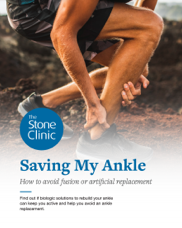When To Have Ankle Surgery
The ankle is a unique joint, rarely getting arthritis without an injury. It calls for early surgical repair when non-operative methods fail.

The relatively small ankle joint, compared to the knee or hip, handles the entire body weight of 2-3 million steps per year and doesn’t degrade. Only after an injury do the signs of arthritis, cartilage wear, pain, and inflammation appear. The difference in the cartilage within this joint gives surgeons novel opportunities to repair it when arthritis sets in.
The ankle joint is primarily made up of the end of the shin bone, the tibia, and the talus, a complex-shaped bone covered in articular cartilage. The ligaments that guide these bones are short, thick, and tough. Despite this one million ankle ligament injuries occur in the US each year. 75% of them to the anterior talon-fibular ligament, the ligament injured in the classic inward twisting of the foot. Most heal on their own speeded up by ice, compression, and soft tissue massage which are helpful in reducing swelling and pain. Swelling slows down healing. So injections of PRP, growth factors, are deployed on many athletes to speed the healing—though the data on this is not strong.
Surgical repair is deployed when the ankle is completely dislocated or when the ligaments have been injured so often that they fail to heal with normal ankle stability. People complain of an unstable ankle…and are at risk for falls. These ligaments are easily repaired, preferably with a direct suture repair. Complex ankle ligament reconstructions with implants and grafts are rarely needed.
Arthritis sets in if the ankle is not stable or if after fracture the reduction of the bones does not lead to perfectly smooth surfaces. Ankle cartilage repair procedures have improved. Our bias is to use an articular cartilage paste graft technique, but other forms of plugs and matrices have their proponents as well. Leaving cartilage injuries alone in the ankle leads to worse arthritis over time.
Isolated cartilage lesions either from trauma or from osteochondritis dissecans, a disease of cartilage sometimes seen in teenagers, can also be directly repaired with these cartilage grafting techniques. No injection technique of growth factors or cells has reliably been shown to work in isolation for these lesions.
Severe arthritis of the ankle used to only be treated with either fusion or ankle replacement. Fusion can lead to a pain-free ankle but, over time, leads to wearing out of the joints below the fusion. Ankle replacements have improved from a dismal beginning to being useful for low-demand patients.
Something unique about the biology and the cartilage in the ankle has permitted us to trial a novel approach. Surprisingly, in our hands, a complete debridement of a severely arthritic joint with cartilage grafting of the worst areas of contact has led to a return to sports in a selected group of patients all of whom were told to have an ankle fusion. This data is still being developed so this technique has yet to be widely used.
The unusual properties of the ankle will teach us how to expand cartilage regeneration to other joints. Yet, it is still best to avoid the degeneration by stabilizing the ankle early with an accurate reduction of breaks and tears. Listen up when the ankle talks. It is talking about the future.

